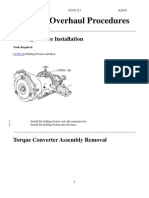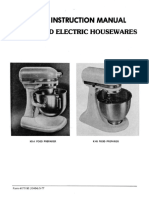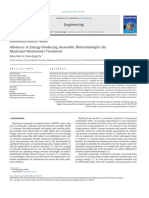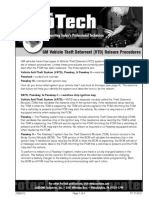Post Anoxic EBPR
Uploaded by
dalesoong2Post Anoxic EBPR
Uploaded by
dalesoong2ADVANCING A NOVEL PROCESS FOR POST‐ANOXIC DENITRIFICATION
Alexander Mockos EIT, Matt Winkler EIT, Erik Coats P.E. Ph.D, University of Idaho, Department of Civil Engineering
Two publications: Coats et al. (2011), Post‐anoxic denitrification driven by PHA and glycogen within EBPR, Bioresource Technology; Winkler et al. (2011), Advancing post‐
anoxic denitrification for biological nutrient removal, Water Research.
INTRODUCTION PROPOSED PROCESS
Reclaimed water standards are becoming increasingly stringent, Post Anoxic Denitrification associated with EBPR:
Post‐Anoxic
pushing wastewater treatment facilities (WWTFs) to expand. For total
The proposed process would operate similar to conventional post‐anoxic
nitrogen removal, WWTFs must integrate internal flow recycling and
denitrification, but without carbon addition. Instead, the process makes use
increase bioreactor volumes. With regard to phosphorus removal,
of Enhanced Biological Phosphorus Removal (EBPR) carbon reserves to
WWTFs must incorporate chemical treatment systems, which
efficiently remove phosphorus, ammonia, and nitrate from the wastewater
significantly increase capital and operational costs as well as the
Completely Mixed
sludge production. With current treatment approaches, the benefit of
improved effluent quality is offset by increased energy usage,
increased operational costs, and decreased operational flexibility; this
Efflue
arguably adds cost both to the environment and to the taxpayer. In our nt
view,
view for a truly sustainable society
society, water reclamation and reuse Influe
nt
Anaerobic Aerobic Anoxic
objectives should be centered on effluent quality in relation to energy Waste
consumption, facility footprint, capital and operational costs, and
process control and flexibility. Time
STUDY OBJECTIVES
Reactors were inoculated with biomass from the Moscow, ID WWTF
Real Wastewater was fed to the reactors
1) Assess the effectiveness of the proposed post‐anoxic VFA rich fermenter liquor was added to wastewater
denitrification with EBPR process Solids Retention Time (SRT) = 20 days
2) Identify the carbon source driving denitrification Hydraulic Retention Time (HRT) = 18 hrs
3) Assess specific denitrification rates (SDNRs) under variable
operating conditions
4) Determine the importance of EBPR and VFA augmentation
ADVANTAGES OF POST
POST‐ANOXIC
ANOXIC EBPR
Eliminates need for internal recycle flows
5) Evaluate the stability of the process in terms of phosphorus Reduces facility footprint
removal and nitrate removal under varied loading conditions Eliminates need for anoxic carbon addition
6) Investigate operational changes that optimize the process Achieves high Phosphorus and Nitrogen removal efficiencies
7) Characterize the bacterial population for Phosphorus High operational flexibility and Control
Accumulating Organisms (PAOs) and Glycogen Accumulating Readily retrofitted to existing SBR facilities
Organisms (GAOs)
RESULTS
1.Effectiveness of Post‐Denitrification with EBPR 3. Importance of VFAs and EBPR 5. Towards Process Optimization
160 25 160 25 160 25
140 AN AE AX AN AE AX AN AE AX
140
monia, Nitrate (mg/L)
20
mg/L)
20 20
Phosphate (mgg/L)
120
Phosphate (mgg/L)
120 Phosphate 120
Phosphate (mg//L)
Ammonia Phosphate
onia, Nitrate (m
Nitrate (mg/L))
100 15 100 15
Nitrate 15
80 Nitrate
80 80
60 10 60 10 10
Phosphate
40 40 40
Ammonia 5 5 5
Amm
Ammo
P
20 Nitrate 20
0 0 0 0 0 0
0.0 1.0 2.0 3.0 4.0 5.0 0.0 1.0 2.0 3.0 4.0 5.0 0.0 1.0 2.0 3.0 4.0 5.0
Time (hr) Time (hr) Time (hr)
Post‐Anoxic
Post Anoxic Nitrate Removal occurred without Process is sensitive to VFA concentration in influent N removal efficiency >90%
compromising EBPR performance EBPR behavior is fundamental for process success Decreasing the aerobic time and lengthening the
P removal Efficiencies on average exceeded 96% as it initiates the cycling of PHA and glycogen which is anoxic time enabled us to access the full
N removal Efficiencies averaged 74%‐ 92% necessary to drive post‐anoxic denitrification denitrification potential of the microorganisms
High SDNRs : 0.85‐1.17 mg NO3 (hr‐g MLVSS)‐1
2. Carbon
b Source Driving
i i Post‐Anoxic
i Denitrification
i ifi i 4 Eff
4. Effects
t off EExcess VFA augmentation
t ti CONCLUSIONS
240 16 280 25 • Post‐anoxic denitrification can accomplish near‐
AN AE AX 14 AN AE AX complete soluble inorganic N and P removal (> 99%).
200 240
20
PHA (mg/gMLLVSS)
12 Glycogen Process success is enhanced at elevated aeration
Nitrate (mgg/L)
Glycogen (mg//L)
Glycogen (mg//L)
160 200 rates but significant removal can be achieved at
rates,
10 Nit t
Nitrate
160 15 reduced aeration.
120 8 • Intracellular glycogen, synthesized associated with
Glycogen 6 120 10 EBPR, is an important carbon source used by the
80
VFAs 4 80 mixed microbial consortium to achieve denitrification.
40 PHA 5 Appositive correlation between the SDNR and
2 40
intracellular glycogen concentration was observed.
0 0 0 0 Furthermore, glycogen oxidization for denitrification
0.0 1.0 2.0 3.0 4.0 5.0 0.0 1.0 2.0 3.0 4.0 5.0 does not compromise subsequent anaerobic VFA
Time (hr) Time (hr) uptake and PHA storage, which is critical to EBPR.
• A mixed VFA substrate (HAc, HPr, HBu, and HVa)
VFAs and internally stored polyhydroxyalkanoates High Nitrate Removal efficiencies (>84%)
appears to be more beneficial to process performance
(PHA) are not present anoxically Effluent Nitrate < 3.2 mg/L
and supports a higher percentage of PAOs than an
No change in MLVSS was observed therefore cell Effluent Phosphorus < 0.09 mg/L
acetate‐dominated substrate.
death cannot be responsible for nitrate removal High SDNRs (1.36 mg NO3 (hr‐g MLVSS)‐1
• Post anoxic secondary P release can occur with NOx
Glycogen utilized anoxically to drive denitrification More influent VFAs = more PHA = more glycogen
depletion. However, P release was only observed
The cycling of PHA and glycogen drives the process available for denitrification = better nitrate removal
when SOT was prevented, and the rate of release was
such that effluent P was only moderately increased.
The post‐anoxic biological nutrient removal process represents a potentially sustainable wastewater treatment • The proposed process configuration is potentially
process: high nutrient removal efficiencies coupled with a small facility footprint, no recycle flows, and no post‐ sensitive to low influent ammonia (< 20 mgN/L), but
anoxic carbon supplementation translate to lower energy requirements and better effluent quality. In addition to stable performance can be maintained by minimizing
reducing energy consumption and operating costs
costs, current EBPR facilities can be readily retrofitted with the SOT
SOT.
proposed process and therefore significantly reduce capital costs associated with a typical process upgrade. • All tested reactor configurations achieved significant P
removal despite variability over time in the relative
PAO fraction, and also considering a relatively
significant GAO population.
You might also like
- Body Controller Diagnostic Trouble Codes International 3200, 4100, 4300, 4400, 7300, 7400, 7500, 7600, 7700, 8500, 8600 Fault Code List PDF100% (7)Body Controller Diagnostic Trouble Codes International 3200, 4100, 4300, 4400, 7300, 7400, 7500, 7600, 7700, 8500, 8600 Fault Code List PDF30 pages
- 1984 GMC Light Duty Trucks Service Manual95% (19)1984 GMC Light Duty Trucks Service Manual1,746 pages
- Detroit GHG17 Heavy Duty Troubleshooting Manual PDF100% (22)Detroit GHG17 Heavy Duty Troubleshooting Manual PDF3,104 pages
- Trailer Life RV Repair and Maintenance Manual (PDFDrive)100% (3)Trailer Life RV Repair and Maintenance Manual (PDFDrive)496 pages
- Wiring Diagrams+Service Manuals+EWD+E-books+Software10% (21)Wiring Diagrams+Service Manuals+EWD+E-books+Software91 pages
- Baya - Bgha - Bvga - Byba - B7wa - Maya - Mfya - MGNo ratings yetBaya - Bgha - Bvga - Byba - B7wa - Maya - Mfya - MG4 pages
- Bendix EC-80 ABS / ATC Controllers: (ABS) Devices Designed To Help Improve The Braking100% (3)Bendix EC-80 ABS / ATC Controllers: (ABS) Devices Designed To Help Improve The Braking44 pages
- Kitchen Aid k45 Service Manual For Hobart Made Vintage Mixers Compress100% (1)Kitchen Aid k45 Service Manual For Hobart Made Vintage Mixers Compress30 pages
- (Hack) Cellular-Manual - Cell Phone Phreaking83% (18)(Hack) Cellular-Manual - Cell Phone Phreaking24 pages
- Automatic Street Light Control System Using IOTppt90% (10)Automatic Street Light Control System Using IOTppt21 pages
- Federalization of Solid Waste in MalaysiaNo ratings yetFederalization of Solid Waste in Malaysia13 pages
- M18 Technologies for Recovering Nutrients From Wastewater - A Critical Review 2019No ratings yetM18 Technologies for Recovering Nutrients From Wastewater - A Critical Review 201919 pages
- 2018 BressaniRibeiro ESWRT ReviewTFpostUASBNo ratings yet2018 BressaniRibeiro ESWRT ReviewTFpostUASB18 pages
- Optimización Del Diseño de Estanques de Estabilización de Desechos para Países en Desarrollo Que Utilizan Dinámica de Fluidos ComputacionalNo ratings yetOptimización Del Diseño de Estanques de Estabilización de Desechos para Países en Desarrollo Que Utilizan Dinámica de Fluidos Computacional11 pages
- Biological Nutrient Removal in Municipal Wastewater Treatment - New Directions in Sustainability - Zhirong HuNo ratings yetBiological Nutrient Removal in Municipal Wastewater Treatment - New Directions in Sustainability - Zhirong Hu11 pages
- Potential Application of Indirect Electrochemical Ammonia Oxidation Within The Operation of Freshwater and Salin-Water RAS, Lahav Et Al., 2015No ratings yetPotential Application of Indirect Electrochemical Ammonia Oxidation Within The Operation of Freshwater and Salin-Water RAS, Lahav Et Al., 201510 pages
- Water Research & Technology: Environmental ScienceNo ratings yetWater Research & Technology: Environmental Science9 pages
- Aerobic Granular Sludge CharacterizationNo ratings yetAerobic Granular Sludge Characterization16 pages
- Introduction To Waste Water Treatment by Root Zone TechniqueNo ratings yetIntroduction To Waste Water Treatment by Root Zone Technique4 pages
- Advances in Energy Producing Anaerobic Biotechnologies For Muni - 2016 - EngineeNo ratings yetAdvances in Energy Producing Anaerobic Biotechnologies For Muni - 2016 - Enginee9 pages
- 4 - Pilot Demonstration of Nitrogen Removal From Municipal Wastewater by Vacuum Membrane DistillationNo ratings yet4 - Pilot Demonstration of Nitrogen Removal From Municipal Wastewater by Vacuum Membrane Distillation9 pages
- Up-Concentration of Nitrogen From Domestic Wastewater A SustainableNo ratings yetUp-Concentration of Nitrogen From Domestic Wastewater A Sustainable13 pages
- Cost Coupled Removal Efficiency Analyses of As Technologies To Achieve The Cost-Effective WWTNo ratings yetCost Coupled Removal Efficiency Analyses of As Technologies To Achieve The Cost-Effective WWT10 pages
- Activated Carbon For Waste Water Treatment v2 N100% (1)Activated Carbon For Waste Water Treatment v2 N8 pages
- Techno-economic_analysis_of_olive_wastewater_treatNo ratings yetTechno-economic_analysis_of_olive_wastewater_treat14 pages
- Bioelectrochemically Assisted Anaerobic Composting Process en 2015 BioresourNo ratings yetBioelectrochemically Assisted Anaerobic Composting Process en 2015 Bioresour7 pages
- Carlson 2021 Comparison of Hybrid Membrane Aerated Biofilm ReacNo ratings yetCarlson 2021 Comparison of Hybrid Membrane Aerated Biofilm Reac11 pages
- OSE 5.inactivation of Enterococcus Sp. by Conventional and Advanced Oxidation Processes in Synthetic Treated Urban WastewaterNo ratings yetOSE 5.inactivation of Enterococcus Sp. by Conventional and Advanced Oxidation Processes in Synthetic Treated Urban Wastewater10 pages
- Effects of Fulvic Acid On The Denitrification Performance of CompletelyNo ratings yetEffects of Fulvic Acid On The Denitrification Performance of Completely12 pages
- Characterization of Brewery Wastewater CompositionNo ratings yetCharacterization of Brewery Wastewater Composition4 pages
- da-silva-et-al-2024-treatment-of-organics-in-wastewater-using-electrogenerated-gaseous-oxidantsNo ratings yetda-silva-et-al-2024-treatment-of-organics-in-wastewater-using-electrogenerated-gaseous-oxidants9 pages
- Biological Nutrient Removal: Sneha G K 4SU17CV039 VIII Sem, Civil Engg SDM I T, UjireNo ratings yetBiological Nutrient Removal: Sneha G K 4SU17CV039 VIII Sem, Civil Engg SDM I T, Ujire23 pages
- Treatment of Milk Wastewater Using Up-Fl Ow Anaerobic Packed Bed ReactorNo ratings yetTreatment of Milk Wastewater Using Up-Fl Ow Anaerobic Packed Bed Reactor5 pages
- Biodegradation Kinetics of Organic Micropollutants in Biofilters For Advanced Wastewater Treatment - Impact of Operational Conditions and Biomass Origin On RemovalNo ratings yetBiodegradation Kinetics of Organic Micropollutants in Biofilters For Advanced Wastewater Treatment - Impact of Operational Conditions and Biomass Origin On Removal12 pages
- Optimization of Reactor Depth in Membrane Bioreactors For Municipal Wastewater TreatmentNo ratings yetOptimization of Reactor Depth in Membrane Bioreactors For Municipal Wastewater Treatment8 pages
- Brochure CE 705 - Activated Sludge Process ENNo ratings yetBrochure CE 705 - Activated Sludge Process EN9 pages
- Modeling and Simulation of A Two-Step SBR Wastewater Treatment PlantNo ratings yetModeling and Simulation of A Two-Step SBR Wastewater Treatment Plant6 pages
- 2011 - Pophali Et Al - Treatment of Refractory Organics From Membrane Rejects Using OzonationNo ratings yet2011 - Pophali Et Al - Treatment of Refractory Organics From Membrane Rejects Using Ozonation5 pages
- A Study of The Garbage Enzyme's Effects in Domestic WastewaterNo ratings yetA Study of The Garbage Enzyme's Effects in Domestic Wastewater6 pages
- Lee Et Al 2023 Oxidative Water Treatment The Track AheadNo ratings yetLee Et Al 2023 Oxidative Water Treatment The Track Ahead2 pages
- CS5 Design, economic evaluation and optimization of enzymatic membrane reactors for antibiotics degradation in wastewatersNo ratings yetCS5 Design, economic evaluation and optimization of enzymatic membrane reactors for antibiotics degradation in wastewaters17 pages
- Development and application of biogas project for domestic sewage treatment in rural China- opportunities and challengesNo ratings yetDevelopment and application of biogas project for domestic sewage treatment in rural China- opportunities and challenges13 pages
- Visualizing Physical Geography 1st Edition Alan H. Strahler download100% (1)Visualizing Physical Geography 1st Edition Alan H. Strahler download47 pages
- Test Frequency and Acceptance Criteria: Subgrade/Shoulder/Median75% (4)Test Frequency and Acceptance Criteria: Subgrade/Shoulder/Median6 pages
- Stephanie Paladino (Editor), Shirley J Fiske (Editor) - The Carbon Fix - Forest Carbon, Social Justice, and Environmental Governance-Routledge (2016)No ratings yetStephanie Paladino (Editor), Shirley J Fiske (Editor) - The Carbon Fix - Forest Carbon, Social Justice, and Environmental Governance-Routledge (2016)356 pages
- CLT South Africa Xlam Brochure-Version-2.0No ratings yetCLT South Africa Xlam Brochure-Version-2.010 pages
- 2 Medical Demography Dynamic & Composition-1No ratings yet2 Medical Demography Dynamic & Composition-167 pages
- East Africa University Bosaso, Puntland Somalia Faculty of Medicine Communicable Disease MR Buruj Ali SaladNo ratings yetEast Africa University Bosaso, Puntland Somalia Faculty of Medicine Communicable Disease MR Buruj Ali Salad42 pages























































































































